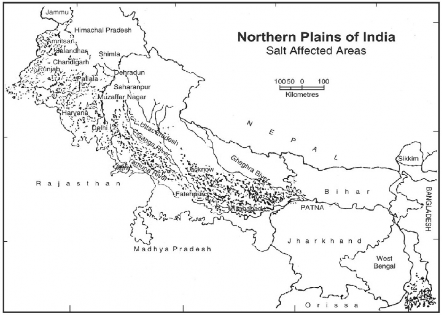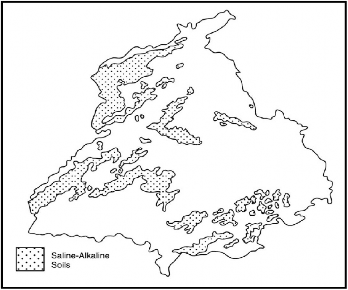1. Salination
The High Yielding varieties of rice and wheat require several waterings, especially in an area like Punjab and Haryana in which the average annual rainfall is about 65 cm. The continuous supply of moisture through irrigation during the summer and winter seasons have changed the soil chemistry. In the arid and semi- arid areas, owing to capillary action, the soils are becoming either acidic or alkaline. The saline and alkaline affected tracts, locally known as kallar or iAurin Punjab and kallar or rcAin Uttar Pradesh have expanded and increased in area. According to one estimate, about 50 per cent of the total arable land of Punjab and Haryana has been harmed by soluble salts. The saline and alkaline affected areas have been shown in Fig. 9.15 and Fig. 9.16.
It may be observed from Fig. 9.15 and Fig. 9.16 that some of the best agricultural tracts have been adversely affected and rendered useless from the agricultural point of view. If the existing pattern of crops and their rotation is not changed more agricultural land may become unproductive.

Source: Waste Land Map of India, 1980-82 Prepared by N.R.S. a Govt, of India
Fig. 9.15 Satluj-Ganga Plain: Salt Affected Land

Fig. 9.16 Punjab—Soil Salinity
Source: Punjab Agri Univ. Ludhiana
The problem of salinity and alkalinity can be solved by use of manure (cowdung, compost, and green manure) and by a judicious selection of leguminous crops in the rotation. Cultivation of salt tolerant crops like barley, sugar-beet, salt grass, asparagus, spinach, and tomato may also help to a great extent and may improve the fertility of such lands.
